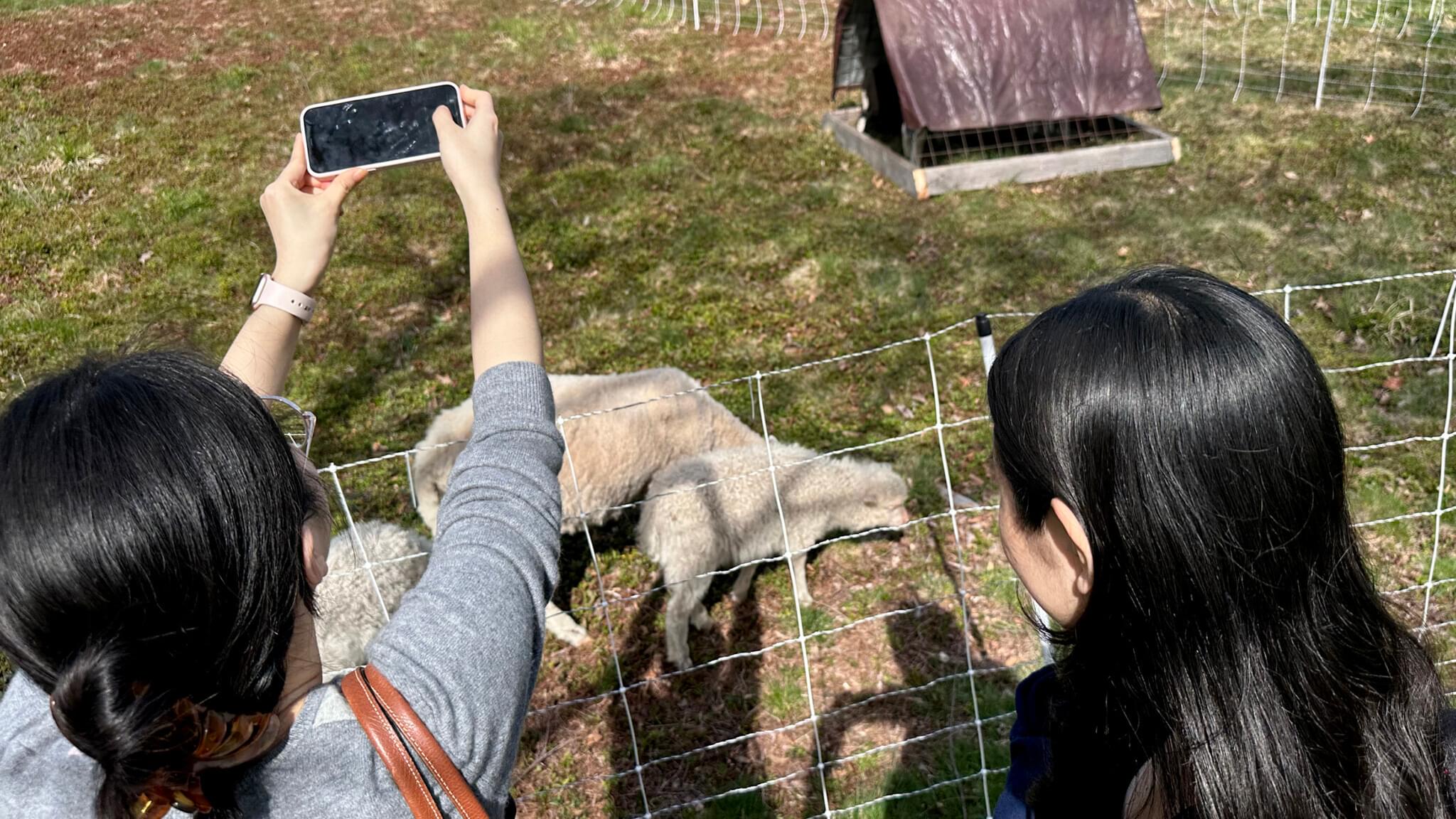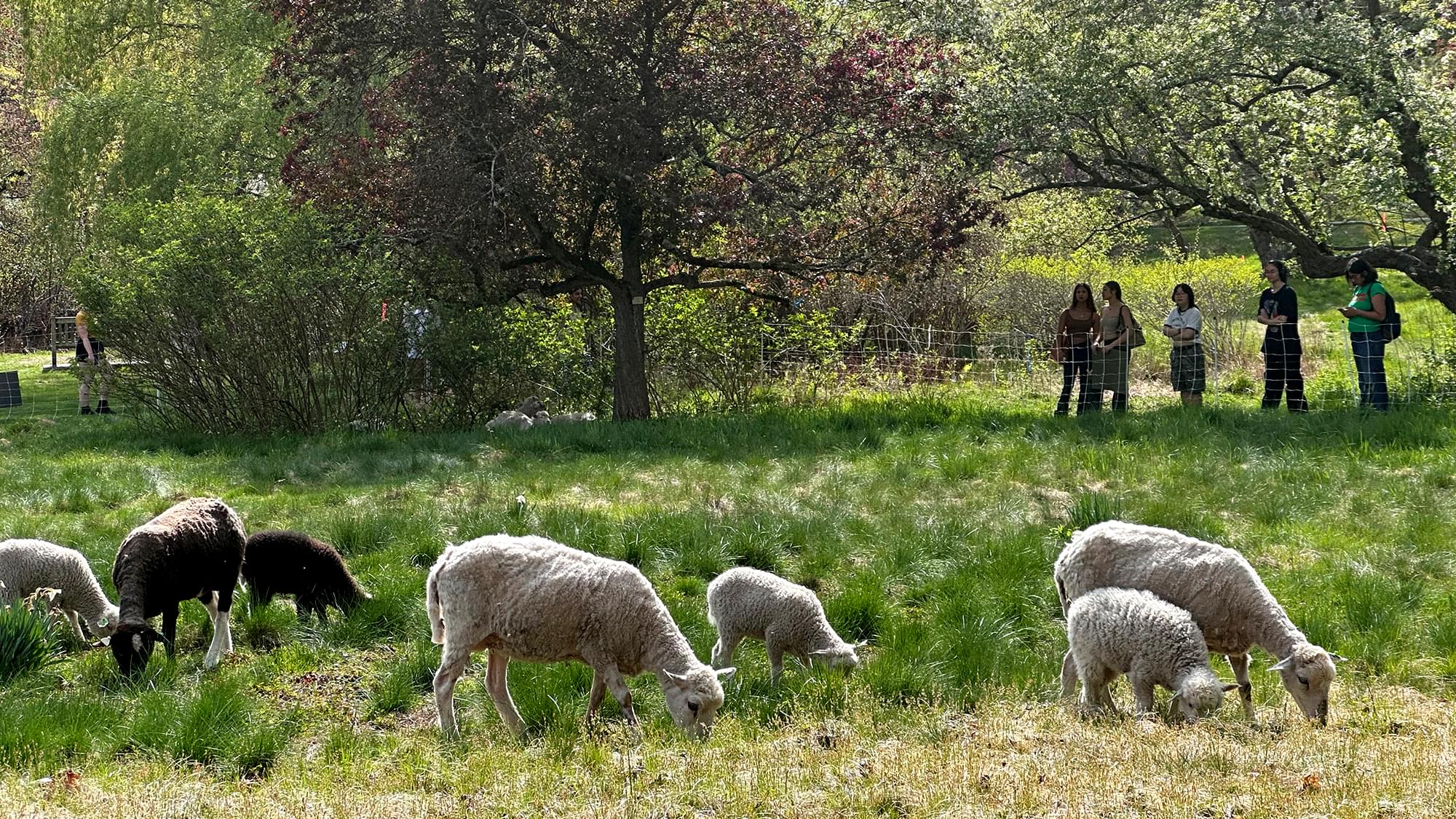Students, faculty, and staff are flocking to the Meandering Meadow behind Paramecium Pond to welcome some very special campus guests: 13 sheep who are visiting the College until May 9 as part of the first-ever Wooly Wellesley event.
When the sheep arrived last Friday, dozens of students and even some children from the Wellesley Community Children’s Center were on hand to see the mix of adults and lambs exit the trailer and follow Haley Goulet, the livestock manager at their usual home, Natick Community Organic Farm (NCOF), into the meadow. Wellesley faculty and staff stood along the fence (caution, it’s electric!), watching in delight as the sheep frolicked.
The sheep are on campus for two reasons, says Anne Beckley, senior gardens horticulturist at the Wellesley College Botanic Gardens. First, they are helping the College kickstart a land management project to expand the diversity of species and amount of flowers in the meadow, which will increase food and habitat for pollinators and other wildlife—all the way down to insects, fungi, and microbes that live in the soil.
“These species will also make the meadow more beautiful for human enjoyment and exploration,” says Beckley. “We hope to grab people’s attention and draw them off the paved paths and into the garden.”
Beckley led the effort to bring the sheep to campus through a partnership with NCOF. The sheep will mow (eat) and fertilize (poop), all while not using any fossil fuels. Beckley usually mows the meadow herself once a season, but the piles of cut grass create a thick thatch that is hard for other plants to penetrate. The hungry sheep will leave no grass clippings behind.

The second reason involves the timing. “We wanted the sheep to visit over reading period and finals to be a stress-relief event for students,” says Beckley. “People can take a break from studying, come out, relax, watch the sheep, just chill out a bit, and enjoy some of the activities we have set up. We are hoping this will become an annual event.”
“Many students can share the experience of seeing therapy dogs on campus, but few can say that their college invited sheep,” says Xiaoran Li ’28, who was excited to watch the woolly landscape technicians. “The fact that the sheep are being productive—that their grazing is contributing toward the meadow-restoration program—makes their visit even more unique.”
While the sheep look cuddly, these are working animals, so hands-on interactions are not allowed. (Note that the electric fence is in place to protect the sheep from predators like coyotes and not from college students looking for a pet lamb, though “that’s an added bonus,” jokes Beckley.)
Though the meadow won’t double as a petting zoo, the Botanic Gardens team has planned plenty of interdisciplinary hands-on activities to take advantage of the sheep’s time on campus. Student interns and staff from the Paulson Ecology of Place Initiative hosted a wool-dyeing workshop using natural dyes, while the art department invited students to come to the meadow to practice live drawing using the sheep as models. Regular “Ask a Farmer” sessions are also scheduled throughout the week, as are “Ask a Horticulturist” sessions featuring Beckley, Botanic Gardens post-baccalaureate fellow Elise Crawford-Paz Soldán, Lucia Chen ’26, Lucia Corte ’26, Maya Escobosa ’27, and others who work on the Botanic Gardens outdoor horticulture team.

“When we were working here over the summer, a lot of us were jokingly asking for sheep or goats on campus,” says Corte. “So it’s nice that it’s actually happening!”
“Having sheep here is such a fun way to engage students with the Botanic Gardens,” says Chen. “A lot of people haven’t seen lambs before, and it’s also nice to increase awareness about the Natick Community Organic Farm.”
“The sheep are here not just for land management, but also student wellness, community engagement, and research,” says Crawford-Paz Soldán.
Beckley adds that since the sheep’s arrival, she has seen many new faces at the Botanic Gardens, which is exciting as the outdoor horticulture team has been renaming many spaces in the gardens to attract more visitors, including the meadow. “We came up with ‘meandering,’ trying to encourage people to spend more time here,” says Crawford-Paz Soldán. “We want people to see that it’s not a place that you just pass through, but a place to spend time, enjoy the wildflowers, and relax.”
“In my time working at the Botanic Gardens, I’ve realized that the campus is so much bigger than you think if you just spent time walking between the academic buildings and the dorms,” says Escobosa. “I think it’s nice that we get to bring all these people who would never have come down here into this beautiful meadow … we have this lovely, lush, botanic garden right here that people should be spending more time in! The sheep draw people in.”
—
The sheep will be in the Meandering Meadow near Paramecium Pond until Friday, May 9, around noon. For more information about the activities and events scheduled for the rest of the week, check out the Wooly Wellesley website.
Want more sheep content? Check out this Instagram video by social media manager Liz Hoveland.

